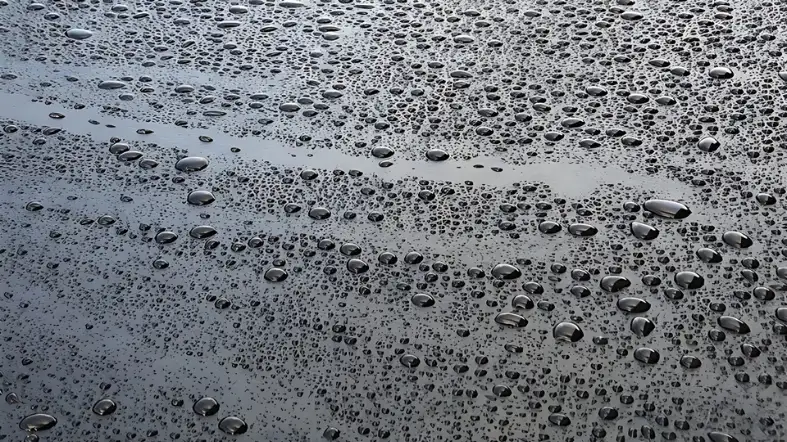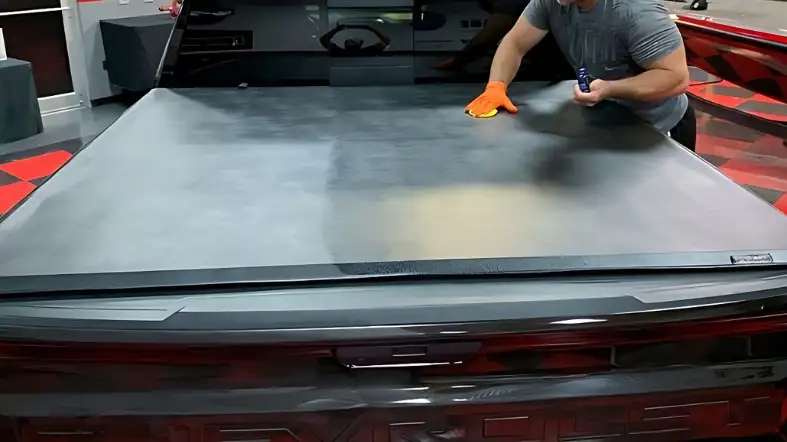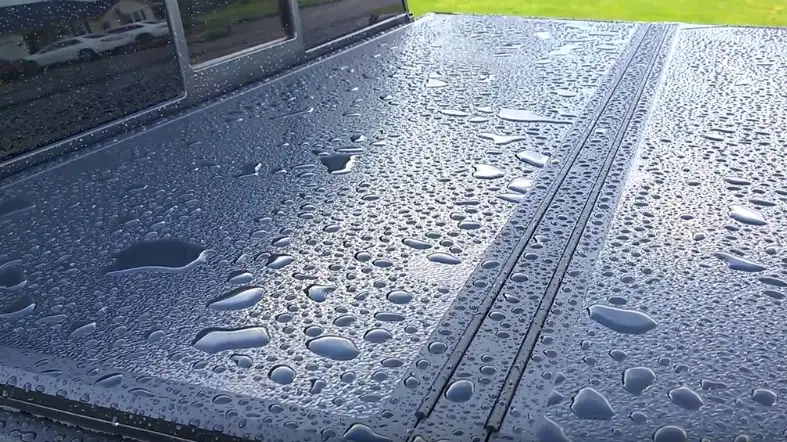Are you tired of water seeping into your truck bed? Looking for ways to protect your cargo from rain, snow, and moisture?
In this blog post, I’ll share effective tips on how to waterproof your tonneau cover. From simple DIY methods to specialized products, I’ve got you covered.
Say goodbye to water damage and ensure your belongings stay dry and secure. Let’s unlock the secrets of waterproofing your tonneau cover.

How To Waterproof A Tonneau Cover?
Here are step-by-step guides to waterproof a tonneau cover:
Step 1: Clean the Tonneau Cover
To begin waterproofing your tonneau cover, start by thoroughly cleaning it.
Use a mild soap or specialized tonneau cover cleaner and a soft brush or sponge to remove any dirt, debris, or stains. Pay close attention to the crevices and seams of the cover.
Rinse the cover with clean water and allow it to dry completely before moving on to the next step.
This step ensures that the waterproofing treatment adheres properly to the cover’s surface.
Step 2: Choose the Right Waterproofing Product
Selecting the appropriate waterproofing product is crucial for effectively protecting your tonneau cover.
There are several options available, each with its own benefits and considerations. Here are some popular choices:
Waterproof Spray or Liquid
Look for a high-quality waterproofing spray or liquid that is specifically designed for outdoor fabrics.
These products create a protective barrier on the surface of the tonneau cover, preventing water from seeping through.
Make sure to read the product label and ensure that it is compatible with the material of your tonneau cover.
Consider factors such as durability, UV resistance, and ease of application when making your selection.
Waterproof Sealant
A waterproof sealant is another option to consider. It is typically a spray-on or brush-on product that forms a protective coating over the tonneau cover.
The sealant helps to repel water and keep it from penetrating the cover’s surface.
Ensure that the sealant is suitable for the material of your tonneau cover and follow the manufacturer’s instructions for application.
Waterproof Tape
If your tonneau cover has any gaps, cracks, or seams that may allow water to enter, waterproof tape can be an effective solution.
Waterproof tape is designed to create a tight seal and prevent water from seeping through the openings.
Look for a high-quality, weather-resistant tape that is specifically designed for outdoor use. Clean and dry the area before applying the tape to ensure proper adhesion.
Waterproof Caulk
Waterproof caulk is a versatile option that can be used to seal gaps or cracks in the tonneau cover.
It is typically applied with a caulking gun and forms a durable, watertight seal.
Make sure to choose a waterproof caulk that is compatible with the material of your tonneau cover.
Clean the area thoroughly before applying the caulk and follow the manufacturer’s instructions for proper application and drying time.
When selecting a waterproofing product, consider the specific needs of your tonneau cover, such as its material, exposure to sunlight, and any existing damage or vulnerabilities.
Step 3: Test in an Inconspicuous Area
Before applying the waterproofing product to the entire tonneau cover, perform a patch test in an inconspicuous area.
This allows you to ensure that the product does not cause any discoloration or damage to the cover’s material.
Apply a small amount of the waterproofing product to the test area and follow the instructions provided by the manufacturer.
After the product has dried, inspect the test area for any adverse effects. If there are no issues, proceed to the next step.
Step 4: Apply the Waterproofing Product
Once you have confirmed that the waterproofing product is safe for your tonneau cover, it’s time to apply it. Begin by shaking the product well to mix its contents.
Hold the can or bottle at a distance recommended by the manufacturer and spray an even layer of the waterproofing solution onto the tonneau cover’s surface.
Make sure to cover the entire area, including the seams and edges.
For liquid waterproofing products, you can use a clean sponge or brush to apply the solution evenly.
Follow the manufacturer’s instructions regarding drying time and reapplication, if necessary.
Step 5: Allow Sufficient Drying Time
After applying the waterproofing product, allow the tonneau cover to dry completely.
This typically involves letting it sit undisturbed for several hours or overnight, depending on the product’s instructions.
Avoid exposing the cover to rain or moisture during this drying period.
Adequate drying time ensures that the waterproofing treatment bonds effectively with the cover’s material, enhancing its resistance to water penetration.
Step 6: Regular Maintenance
To maintain the waterproofing capabilities of your tonneau cover, it is essential to perform regular maintenance.
Clean the cover periodically using a mild soap or specialized cleaner, as mentioned in Step 1.
Remove any dirt, debris, or stains promptly, as they can compromise the waterproofing properties over time.
Step 7: Inspect and Reapply as Needed
Periodically inspect your tonneau cover for any signs of wear or diminished waterproofing.
Over time, the effectiveness of the waterproofing treatment may decrease due to exposure to weather conditions.
Check for areas where water may be seeping through or areas that have lost their water-repellent properties. If you notice any issues, it’s time to reapply the waterproofing product.
Clean the tonneau cover as outlined in Step 1 and follow the instructions provided by the manufacturer to apply the waterproofing product again. Make sure to focus on the problem areas and ensure thorough coverage.
Regularly maintaining and reapplying the waterproofing treatment will help prolong the lifespan of your tonneau cover and keep it well-protected against water damage.
Step 8: Consider Additional Protective Measures
In addition to waterproofing the tonneau cover itself, you may want to consider additional protective measures to enhance its durability and resistance to water.
For example, installing a tonneau cover support system can prevent water from pooling on the surface during heavy rain. These support systems elevate the cover, allowing water to flow off more easily.
You can also use a tonneau cover cleaner and protectant specifically designed to maintain the cover’s water-repellent properties.
These products help to remove dirt, grime, and contaminants while adding a protective layer that enhances water resistance.
Furthermore, regularly tightening any fasteners, such as snaps or Velcro straps, will ensure a secure and snug fit, minimizing the risk of water entering through gaps or loose areas.
Maintaining the Waterproofing of Your Tonneau Cover

By following these steps, you can keep your cover in excellent condition and prevent any water leakage that may compromise the cargo in your truck bed.
1. Clean the Tonneau Cover Regularly
To maintain the waterproofing of your tonneau cover, it’s important to keep it clean from dirt, debris, and other contaminants.
Use a mild soap or specially formulated cleaner that is compatible with the material of your cover.
Gently scrub the surface with a soft brush or sponge, paying close attention to any areas with stains or buildup.
Rinse thoroughly with water and allow it to dry completely before proceeding to the next step.
2. Inspect for Damage or Wear
Regularly inspect your tonneau cover for any signs of damage or wear that may compromise its waterproofing abilities.
Look for tears, cracks, or loose seams that could potentially allow water to seep through.
If you notice any such issues, it’s crucial to address them promptly to prevent further damage.
Depending on the severity of the damage, you may need to repair or replace the cover.
3. Apply a Protective Sealant
To enhance the waterproofing of your tonneau cover, consider applying a protective sealant.
There are various sealant options available, such as spray-on or wipe-on formulas. Before applying the sealant, ensure that the cover is clean and dry.
Follow the manufacturer’s instructions for the specific sealant you are using, and apply it evenly across the entire surface of the cover.
Allow the sealant to dry completely before exposing the cover to any moisture.
4. Lubricate Moving Parts
If your tonneau cover has moving parts, such as hinges or latches, regular lubrication is essential to maintain their functionality and prevent water intrusion.
Use a lubricant specifically designed for automotive applications and apply it to the moving parts according to the manufacturer’s instructions.
Be careful not to over-apply the lubricant, as excess grease or oil can attract dirt and debris.
5. Check the Drainage System
Many tonneau covers feature a built-in drainage system to channel water away from the truck bed.
It’s important to check this system regularly and ensure that it is free from any obstructions.
Clear away any debris or leaves that may have accumulated in the drainage channels or tubes.
This will help prevent water from pooling on top of the cover and potentially finding its way into the truck bed.
6. Avoid Excessive Weight on the Cover
To maintain the waterproofing of your tonneau cover, it’s crucial to avoid placing excessive weight on top of it.
Heavy items can put a strain on the cover and potentially compromise its integrity.
If your cover is not designed to support heavy loads, consider using a bed extender or other accessories to distribute the weight more evenly across the truck bed.
Common Mistakes to Avoid When Waterproofing Tonneau Covers
Identifying and addressing common mistakes when waterproofing tonneau covers is crucial to ensure the protection of your truck bed and cargo.

By avoiding these errors, you can prevent water damage and maintain the functionality of your tonneau cover.
Insufficient Cleaning
To establish a secure and watertight seal, it is essential to thoroughly clean the tonneau cover and truck bed before waterproofing.
Neglecting this step can lead to poor adhesion and compromised effectiveness.
Use a mild detergent or specialized cleaner to remove dirt, debris, and any remnants of previous sealants.
Pay extra attention to crevices and hard-to-reach areas. Rinse the cover and truck bed thoroughly and allow them to dry completely before moving on to the next step.
Inadequate Surface Preparation
Proper surface preparation is key to ensuring a successful waterproofing application.
Failing to adequately prepare the tonneau cover and truck bed can result in reduced adhesion and a weak seal.
Before applying any waterproofing product, sand down any rough or uneven areas on the cover and truck bed.
This process promotes better adherence to the sealant, maximizing its effectiveness.
Use fine-grit sandpaper and wipe away any dust or debris before proceeding.
Choosing the Wrong Sealant
Selecting the appropriate sealant is crucial for achieving a reliable and long-lasting waterproofing solution.
Avoid using silicone-based sealants, as they may not adhere well to the tonneau cover material and can deteriorate over time.
Instead, opt for specialized waterproofing products designed specifically for tonneau covers.
These products offer superior adhesion and durability, ensuring effective water resistance for an extended period.
Applying Sealant Incorrectly
Applying the sealant improperly can compromise its effectiveness and lead to water leakage.
When applying the sealant, follow the manufacturer’s instructions carefully.
Use a brush or roller to ensure even coverage and avoid excessive buildup, which can result in clumping and ineffective sealing.
Pay close attention to the seams and edges of the tonneau cover, as these areas are most susceptible to water infiltration.
Neglecting Regular Maintenance
Even with proper waterproofing, tonneau covers require regular maintenance to preserve their effectiveness.
Failing to maintain the sealant can result in diminished water resistance over time. Routinely inspect the tonneau cover for signs of wear, damage, or peeling sealant.
If necessary, reapply the waterproofing product following the manufacturer’s guidelines.
Additionally, clean the tonneau cover regularly to prevent the buildup of dirt and debris, which can compromise the seal.
Professional Waterproofing Services: Is It Worth It?
When it comes to protecting your home or building from water damage, you may find yourself wondering if professional waterproofing services are worth the investment.
Here, we’ll delve into the benefits of hiring professionals for waterproofing tasks and help you decide whether it’s worth it for you.
Thorough Assessment and Diagnosis
One significant advantage of professional waterproofing services is their expertise in conducting a thorough assessment of your property.
These experts possess in-depth knowledge of potential problem areas and can identify vulnerabilities that may not be apparent to an untrained eye.
Tailored Waterproofing Solutions
Professional waterproofing companies can provide customized solutions to address your specific needs.
They have access to a wide range of waterproofing products and techniques, allowing them to select the most suitable options for your situation.
Quality Workmanship
One key aspect of professional waterproofing services is the high standard of workmanship they bring to the table.
These experts are trained and experienced in executing waterproofing projects with precision and attention to detail.
By relying on their expertise, you can have confidence that the work will be carried out to a professional standard.
Long-Term Cost Savings
Professional waterproofing helps safeguard your property’s structural integrity, potentially avoiding expensive foundation repairs, mold remediation, or other major renovations down the line.
Peace of Mind
One often overlooked benefit of professional waterproofing services is the peace of mind they provide.
Knowing that your property is protected against water intrusion can alleviate concerns and reduce stress.
By entrusting the task to professionals, you can focus on other aspects of homeownership or building management, confident that your property is in capable hands.
Can the Soft Tonneau Covers for F150 Be Waterproofed?
Yes, soft tonneau covers for f150 can be waterproofed. These covers are designed to protect your truck bed from the elements, including rain and snow. Some manufacturers offer covers with built-in water-resistant features, while others recommend using additional sealants or accessories for added waterproofing. Ensuring proper installation and maintaining the cover can also contribute to its water-resistant properties.
FAQs
What Type Of Waterproofing Product Should I Use For My Tonneau Cover?
Choose a waterproofing spray or solution that is suitable for the material of your tonneau cover, such as fabric or vinyl.
Where Can I Purchase A Waterproofing Product For My Tonneau Cover?
You can find waterproofing sprays or solutions for tonneau covers at auto supply stores, online retailers, or directly from the manufacturer.
How Often Should I Waterproof My Tonneau Cover?
The frequency of waterproofing your tonneau cover depends on various factors, such as the material, weather conditions, and usage.
It is generally recommended to reapply waterproofing every 6 to 12 months.
Can I Apply Waterproofing To A Damaged Tonneau Cover?
Waterproofing products are designed to enhance the water resistance of your tonneau cover, but they may not be effective for covering significant damage or tears.
It is recommended to repair any damages before applying waterproofing.
Is It Necessary To Clean My Tonneau Cover Before Waterproofing?
Yes, it is essential to clean your tonneau cover thoroughly before applying a waterproofing product.
Remove any dirt, debris, or stains using mild soap and water, and ensure the surface is completely dry before proceeding with waterproofing.
Can I Use Household Waterproofing Products On My Tonneau Cover?
It is not recommended to use generic household waterproofing products on tonneau covers, as they may not be formulated specifically for the material or the demands of automotive applications.
It’s best to use products designed for tonneau covers to ensure optimal results.
Final Words
Protect your tonneau cover from the elements and extend its lifespan with these simple waterproofing tips.
By applying a reliable waterproofing spray and ensuring proper maintenance, you can keep your cover in top condition, preventing water damage and enhancing its durability.
Take proactive steps to shield your tonneau cover from rain, snow, and other weather conditions, ensuring long-lasting protection and peace of mind.
Invest in waterproofing today to safeguard your investment and enjoy a worry-free driving experience.
